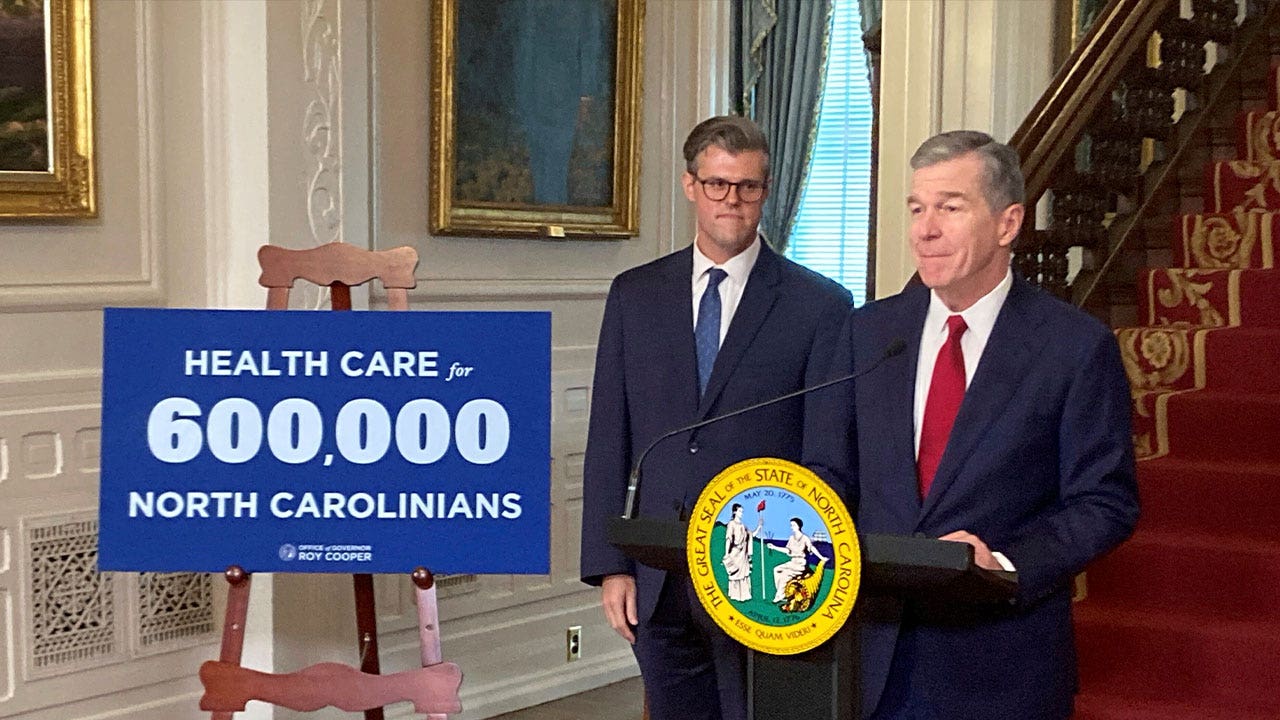North Carolina
North Carolina to expand Medicaid coverage on Dec. 1

Medicaid expansion will launch Dec. 1 in North Carolina, Gov. Roy Cooper announced on Monday after achieving what he’s sought for nearly seven years on the job and what’s possibly his biggest policy win.
Government health insurance should be available to another 600,000 low-income adults, with roughly half of them receiving coverage on Day One. But securing expansion through the Republican-controlled state legislature came with hefty political expenses for the Democratic governor that will be difficult to reverse.
Still, Cooper celebrated the influx of billions of dollars from the federal government that he says will boost rural hospitals, create jobs and help those suffering with pain and illness that they can’t otherwise afford to treat because they are uninsured.
MEDICAID EXPANSION MAY BE ENACTED IN NORTH CAROLINA, PENDING APPROVAL OF FINAL BUDGET
“This has been an unnecessarily long and agonizing journey for many North Carolinians,” Cooper said at an Executive Mansion news conference with health Secretary Kody Kinsley to reveal the start date. “But today, the hope that has stirred in so many across our state will become a reality.”
Cooper said he and Kinsley have talked to federal officials and that a potential government shutdown in Washington shouldn’t delay the Dec. 1 start date.
A landmark bipartisan Medicaid law that Cooper signed in March removed North Carolina from the list of 11 states that at the time hadn’t accepted expansion. The law required a budget to be approved before expansion could be implemented.
Republicans with narrow veto-proof control of the General Assembly piled provisions inside that spending plan, unveiled last week, which weaken Cooper and future governors to the benefit of the General Assembly.
North Carolina Gov. Roy Cooper, right, speaks while state Health and Human Services Secretary Kody Kinsley listens at a news conference in Raleigh on Sept. 25, 2023. Medicaid expansion, supported by Cooper, will finally cover thousands more residents starting Dec. 1. (AP Photo/Gary D. Robertson)
Cooper also had to stomach other policy prescriptions within the budget bill, such as a massive enlargement of the state’s private-school voucher program to all K-12 children regardless of family income.
It appeared Republicans had enough support to override any Cooper veto. Rather than signing the budget bill into law, Cooper announced minutes after it received final legislative approval on Friday that he would let the bill become law without his signature. That means the budget should be enacted Oct. 3.
“I know there’s a lot of bad in the budget that they passed,” the governor said, but “in this legislative circus we can’t take any more chances on delay or defeat with the lives of so many people at stake.”
A state budget was supposed to be in place July 1, but it took 2 1/2 more months to finalize as negotiations slowed among Republicans over income tax reductions and the distribution of billions of dollars for capital improvements, economic development and other areas. A stalemate over whether more gambling should be authorized also briefly threatened whether a budget would get approved.
The state Department of Health and Human Services had said expansion would’ve started Oct. 1 had a budget been completed by the end of August.
NORTH CAROLINA MEDICAID PROGRAM MEANT TO TREAT THOSE WITH MENTAL ILLNESS, DISABILITIES DELAYED AGAIN
Through expansion, adults age 19-64 get coverage even if they make too much to qualify for traditional Medicaid but too little to receive even heavily subsidized private insurance. For example, a single person who makes up to about $20,000 or someone in a family of three that makes $34,000 would benefit.
Nearly 2.9 million people are currently enrolled for Medicaid in North Carolina. Kinsley, the health secretary, said roughly 300,000 people who participate in a limited Medicaid program for family planning benefits and who meet income requirements will automatically be registered for full Medicaid benefits.
Additional recipients will accumulate as people learn about the expansion and county social service offices enroll them, Kinsley said.
To those who’ll benefit from expansion, Kinsley said, “I have one final message: We’ve got you covered.”
CLICK HERE TO GET THE FOX NEWS APP
Within days of taking office in January 2017, Cooper tried to get expansion initiated before the Obama administration ended. But a 2013 law required express approval of the General Assembly before expansion could be sought, and a federal court blocked Cooper’s efforts.
Cooper vetoed the state budget in 2019 because legislative leaders wouldn’t commit to Medicaid talks. That led to a protracted impasse and a traditional state budget was never approved that year.
“I don’t regret a single attempt to expand Medicaid because I think it has led us to this day,” Cooper said Monday.
By mid-2022 both the House and Senate had passed competing expansion measures.
Top Republican leaders said they changed their opinion on expansion because traditional Medicaid was on firmer fiscal ground compared to the early 2010s. They were also attracted to a financial bonus for the state from Congress should North Carolina accept expansion. Hospital leaders, Republican sheriffs and county GOP officials also lobbied them to accept expansion.
President Joe Biden acknowledged on Monday the expansion accomplishment in a written statement, praising “bipartisan elected officials” as well as Cooper, whom he cited for “years of leadership fighting to get this monumental step forward for North Carolina families done.”

North Carolina
NC has some of the most dangerous roads in the US: See how Wilmington-area counties rank
With a recent study revealing North Carolina as one of the states with the riskiest roads to travel, some may wonder how safe the roads are here in the Cape Fear region.
MarketWatch Guides, a site that provides “reviews of consumer products and services to help readers make educated purchasing decisions,” focuses in part on car insurance comparisons, vehicle safety and more.
A recent study by the site analyzed factors including annual miles driven per 100,000 system miles, percentage of rough roads and fatal injuries per 100,000 licensed drivers. States were given a rating out of 10 points, with 10 being the most dangerous.
More: Distracted driving in Wilmington: How big of a problem is it?
North Carolina’s ranking among the most dangerous
According to the study, the states with the most dangerous drivers based on the factors studied are:
- Louisiana – 7.55/10
- California – 7.21/10
- New Mexico – 6.74/10
- Hawaii – 6.73/10
- Delaware – 6.67/10
- New Jersey – 6.53/10
- Mississippi – 6.47/10
- North Carolina – 6.39/10
- Massachusetts – 6.33/10
- Maryland and Texas – 6.26/10
According to the study, North Carolina had 32.5 fatal injuries per 100,000 licensed drivers, but only 2.1% of rough roads, which was the lowest percentage out of the other ranked states.
For a more localized perspective, the North Carolina Department of Transportation releases annual traffic crash facts data. The most recent 2022 report includes a ranking of counties based on several factors, including reported crashes, crash severity, crash rates based on population, registered vehicles and estimated vehicle miles traveled.
The most dangerous county for drivers, ranked at No. 1 for the past five years, was Robeson County. The county had 60 fatal crashes in 2022 with 1,136 non-fatal injury crashes. The rest of the total 4,056 crashes were property-damage-only. The county with the best ranking was Hyde County, coming in at No. 100. The county had one fatal crash in 2022 and 10 non-fatal injury crashes. The county had a total of 45 crashes, the rest of which were property damage only.
More: MyReporter: Which intersections see the most red-light camera violations in Wilmington?
Here’s where the Cape Fear region counties ranked.
Brunswick County
Ranked No. 76 in 2022, Brunswick County had 25 fatal crashes and 715 non-fatal injury crashes. The total crashes for that year were 3,146. The remainder of the crashes were property damage only.
New Hanover County
Ranked No. 58, New Hanover had 19 fatal crashes and 1,313 non-fatal injury crashes, both of which went down from 2021. The total crashes in New Hanover were 5,617. The remainder of the crashes were property damage only.
Pender County
Ranked No. 47, Pender County had the worst ranking despite having the lowest number of crashes. The county had 12 fatal crashes and 374 non-fatal injury crashes, and a total of 1,156 crashes. The rest of the crashes were property damage only.
Iris Seaton, USA Today Network, contributed to this report.
North Carolina
Tropical Storm Debby expected to bring rainfall to Virginia & North Carolina

Tropical Storm Debby already has parts of Florida under tropical storm warnings. The Florida Big Bend is currently under a Hurricane Warning. Debby is forecast to briefly strengthen into a category 1 hurricane as it moves over the Gulf of Mexico where water temperatures are near 90 degrees.
As it continues its path over land it is expected to dial back to tropical storm strength as it reaches the Carolinas mid to late next week. Moderate rainfall is possible for northeast North Carolina and southern Virginia by the end of the week.

Higher amounts of rain are possible for southernmost portions of the Outer Banks but generally models show 2-4 inches for northeast North Carolina and 1-2 inches for southern Virginia through Thursday.
Stay with News 3’s First Warning Weather Team for the latest updates as the storm develops.
North Carolina
Tropical weather update for Wilmington: What we can expect and when

The National Hurricane Center continues to monitor a tropical depression over Cuba. It’s expected to become a tropical storm later Saturday, bringing impacts to the Carolinas around the middle of next week.
Heavy rainfall and flooding are the primary impacts expected, according to the National Weather Service in Wilmington.
“Gusty winds are also possible, but it is too early to predict specific impacts in great detail at this time,” the weather service said.
At the same time, there is the potential for heavy rainfall and some flooding associated with front expected to stall inland this weekend.
As of 11 a.m. Saturday, the center of the tropical depression, which would be name Debby if it becomes a tropical storm, was over Cuba and moving west-northwest near 15 mph. The hurricane center said a turn toward the northwest is forecast for Saturday, followed by a northward motion on Sunday and then a slower northeastwardmotion Sunday night and Monday.
Maximum sustained winds were near 35 mph. Slow strengthening is expected throughout the day Saturday. Faster strengthening is possible Sunday, with the storm nearing hurricane strength when it reaches the Florida Gulf Coast, the hurricane center said.
STORM TRACKER: Monitor the latest tropical developments here.
Here’s a look at what we can expect in the Wilmington area, according to the latest briefing from the National Weather Service in Wilmington.
Wind
The probability of tropical storm force winds has increased, especially for the South Carolina coast. The most likely time of arrival of for northeast South Carolina is Tuesday night into Wednesday morning, and for Southeastern North Carolina is during Wednesday morning.
Rain
The potential for significant rainfall exists with 8 to 12 inches possible from near Cape Fear to portions of thenortheast South Carolina coast. Flash flooding and urban flooding are possible. Some rivers, including the North Cape Fear River and the Waccamaw River, could exceed flood stage next week.
INTERACTIVE MAP: Enter your address to see hurricanes, tropical storms that have passed nearby
Marine impacts
Rough surf, including dangerous rip currents, and hazardous marine conditions are expected this weekend and will persist into the upcoming week.
Are you prepared for a hurricane?
Hurricane season runs from June 1 to Nov. 30. Even if this system won’t pose a threat to the NC coast, it’s never too early to be prepared.
GET READY: Are you prepared for a hurricane? Here’s what to know if you live in the Wilmington area.
-

 Mississippi5 days ago
Mississippi5 days agoMSU, Mississippi Academy of Sciences host summer symposium, USDA’s Tucker honored with Presidential Award
-

 Politics1 week ago
Politics1 week agoRepublicans say Schumer must act on voter proof of citizenship bill if Democrat 'really cares about democracy'
-
World6 days ago
More right wing with fewer women – a new Parliament compendium
-

 News1 week ago
News1 week agoVideo: Kamala Harris May Bring Out Trump’s Harshest Instincts
-

 Politics1 week ago
Politics1 week agoTrump announces to crowd he 'just took off the last bandage' at faith event after assassination attempt
-

 World1 week ago
World1 week agoIsrael says Hezbollah crossed ‘red line’, strikes deep inside Lebanon
-

 Politics1 week ago
Politics1 week agoHarris failed to combat ‘root causes’ of illegal immigration, former Border Patrol union chief says
-

 Movie Reviews1 week ago
Movie Reviews1 week agoDeadpool & Wolverine Movie Review: Ryan Reynolds brings the house down in this bloody spectacle














